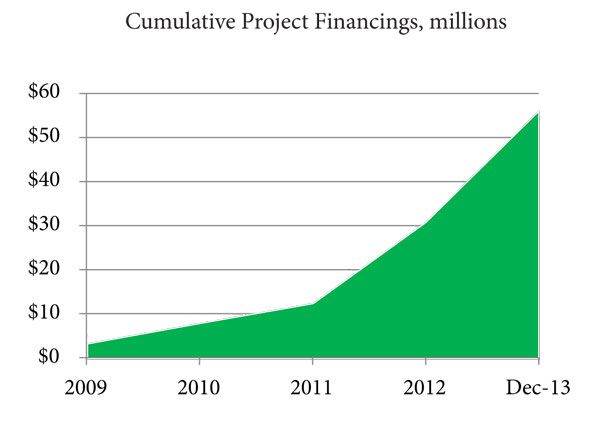Commercial property-assessed clean energy (PACE) financed projects climbed to nearly $60 million in 2013. And that figure will likely swell in the coming years.
There is more than $215 million in PACE project applications in the pipeline, according to PACENow, a nonprofit that promotes PACE programs. Meanwhile, many more such programs are just getting off the ground.

Source: PACENow
PACE allows investments in energy-efficiency retrofits and distributed renewable generation to be paid back through a tax that is tied to the property, which lowers the risk for both lenders and owners and can potentially open up a far larger swath of the energy efficiency market.
California and Connecticut are already two of the most important states for commercial PACE because of the number and scope of their programs. California has taken a city-by-city approach, while Connecticut has employed a state-level approach.
But there are other regions to watch in 2014 as legislators and regulators design unique programs and learn from pioneering states.
Texas. Texas hasn’t financed a dime in PACE projects yet, but the state has big plans to gear up in 2014. The state legislature passed its PACE Act in June of last year. A nonprofit business association, Keeping PACE in Texas, is busy assembling “PACE in a Box” for the entire state.
It has adopted some of the streamlined procedures in place in Connecticut, but the Texas version won’t be as top-down and will allow cities and counties to customize their programs. Charlene Heydinger, executive director of the group Keeping PACE in Texas, expects the first programs to be implemented this year.
Michigan. Sure, California has the largest PACE district, but just behind it is Wayne County, the largest county in Michigan. In early December, the Wayne County Commission created a PACE district as part of the Lean & Green Michigan initiative. Four other counties and six local governments have also joined Michigan’s program.
Wayne County is home to nearly 1.8 million residents and encompasses the city of Detroit. A specific timeline for the program has not yet been announced. Ann Arbor is the only city in Michigan that has already launched its PACE program.
St. Louis. Missouri’s Clean Energy District Program has the advantage of streamlining the process to sign up municipalities across the state. Since there are no public funds available for distribution, signing up doesn’t require a public hearing. Instead, cities can just pass an ordinance.
St. Louis has taken streamlining to the next level, with the launch and financing of its first project in record time, according to PACENow. The first project was a solar array from St. Louis-based Microgrid Solar on the roof of local shop, Four Muddy Paws. The city already has more than $7 million in proposed projects, including a proposal from an environmentally sustainable distillery that’s looking to open in 2014.
Pennsylvania. PACE has not passed the legislature yet in Pennsylvania, but HB 1339 is expected to get through in 2014. The size of the state, coupled with electricity deregulation, mandated demand response and a focus on energy efficiency in Philadelphia all point toward rapid PACE uptake if the measure becomes law.
South Florida. Who says residential PACE programs are dead? In south Florida, the Green Corridor District, which covers Miami, South Miami, Pinecrest, Palmetto Bay, and Miami Shores, offers both residential and commercial PACE financing. Only commercial projects will be allowed in the City of Miami, according to PACENow.
In fall 2013, Ygrene, one of the nation's largest administrators of PACE programs, launched a $230 million bond issuance for PACE in South Florida. Many homeowners are interested, especially those that understand the details of the loans they are taking on. Since Ygrene is a national player in the PACE market, if it can continue to effectively build residential programs in South Florida in 2014, it could be replicated in other regions.



